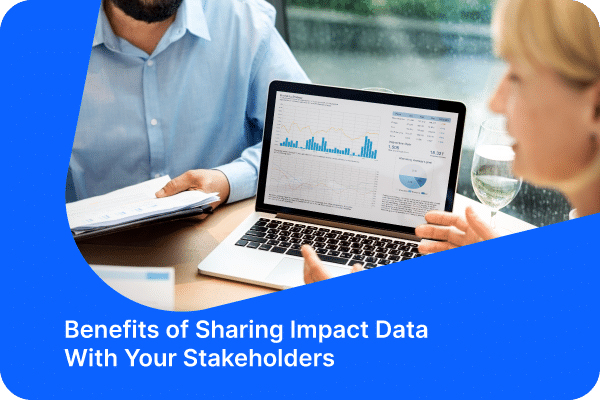
Every day, your nonprofit does the work that moves it closer to achieving its mission, whether that means providing nutritional meals to families in need or mentoring young entrepreneurs. One of the best ways to celebrate your progress is to measure and report on your impact.
But showcasing success isn’t the only reason you should monitor your organization’s impact. Adopting an impact measurement and management process for your nonprofit can also help you foster trust and strengthen relationships with your stakeholders—including grantmakers, corporate sponsors, board members, donors, and volunteers.
In this post, we’ll look closely at some of the core benefits of sharing impact data with your stakeholders. As you review these benefits, consider how your own stakeholder relationships could improve if you prioritized sharing impact. Let’s begin!
First Things First: What is Impact Measurement and Management?
UpMetrics defines impact measurement and management (IMM) as “a process that involves evaluating the effectiveness of an organization’s programs, initiatives, and interventions to determine if the organization is delivering its intended results or benefits to its target beneficiaries.”
This requires nonprofits to look beyond their day-to-day operations to the long-term outcomes they’re creating for those they serve. For instance, your nonprofit may provide job interview training to single mothers looking for employment. IMM allows you to think deeper than your training program and look at how well your organization is setting up the women and families it serves to live better lives.
Understanding the IMM Process
To measure and monitor your impact effectively, your nonprofit should follow these steps:
- Create an Impact Framework. An Impact Framework is a roadmap that helps your nonprofit think about the “how” of measuring its impact. There are several tried-and-true Impact Framework models your organization can use. Regardless of the model you choose, the main idea is to set impact objectives that will help you get closer to accomplishing your mission and select the key performance indicators you can use to monitor progress toward those objectives.
- Consider the data you’ll need. Data is essential to IMM, and you need to be intentional in planning out the data you want to collect. You should plan to work with both quantitative and qualitative data for a fuller picture of your organization’s impact. Numbers don’t tell the whole story of how your organization affects its community! For example, a beneficiary’s testimonial can go a long way in communicating real-world impact and help forge emotional connections with stakeholders.
- Collect data. To collect data relevant to your nonprofit’s impact, identify where your current data is housed, such as in your CRM or marketing platforms. You may want to collect additional data by sending out surveys or conducting focus groups. You can also use publicly available data (such as government agency reports) or reach out to partner organizations that may be willing to share relevant data with you.
- Analyze the data. Next, analyze your data for patterns and trends that tell your organization’s impact story. You may find it useful to leverage a dedicated IMM platform to do this, or you may want to partner with a data scientist.
- Act on your insights. Once you have impact insights to work with, you should act on them. Make improvements in areas where you feel you’re struggling to deliver on what you promised to your community, and do more of what you see is working well.
The last important step in this process is sharing your impact data with your stakeholders. Let’s dig into the benefits of that!
1. Build Trust and Credibility
Traditionally, the relationships between organizations and their stakeholders have been imbalanced, favoring the party with the most power, influence, or financial capacity. This has resulted in transactional and rigid connections, whether between grantmakers and nonprofits who receive funding or nonprofits and their high-profile major donors.
However, by prioritizing sharing impact insights with your stakeholders, you give them a fuller view of what your organization does and why it really matters. This opens the door to a trust-based approach to philanthropy that’s focused on openness, collaboration, and shared success.
Plus, demonstrating that your organization follows through on its promises and being able to point to the tangible results of your work (and stakeholders’ contributions) strengthens your organization’s credibility. Stakeholders can feel more confident in your organization’s ability to make true progress toward its mission.
2. Enhance Stakeholder Engagement
When you share impact data with your stakeholders, you aren’t just showing them that your internal team’s actions matter; you’re also showing them that their contributions make a difference.
Seeing their contributions’ tangible impact can motivate stakeholders to continue supporting your organization. For example, if you show your board members that their efforts to help fundraise for last year’s annual campaign helped you increase your annual fund by 15%, and that those additional funds allowed you to support 60 additional families through your services, you’ll inspire your board members to continue championing your fundraising work. Or, if you demonstrate through testimonials that your volunteers motivate your beneficiaries to continue attending your educational programs, chances are that your volunteers will feel valued, making them more likely to continue giving their time.
You can also think about this benefit from a funder’s perspective. For example, if a grantmaking organization has a clear view of your organization’s performance, they can help you in additional ways besides providing monetary support. They might offer insights about growing your organization that you can weave into your strategic plan, for instance.
3. Inform Strategic Decision-Making
One of the general benefits of IMM is that your organization can make more informed decisions about improving its operations or taking steps that lead to growth or sustainability.
Of course, stakeholders are often involved in strategic decision-making. For example, grantmakers may decide whether to increase their funding to your organization, or board members may have a say in approving your plans to run a fundraising assessment.
Having impact information on hand can be helpful in these situations as stakeholders assist you in making improvements or doing more of what is working well. This is because impact data offers an unfiltered view of both the good and the not-so-good aspects of your nonprofit’s performance, getting everyone on the same page about what needs to happen to help your organization move toward accomplishing its big-picture goals.
4. Attract New Funding and Partnerships
The positive effects of sharing impact data go beyond maintaining relationships with current stakeholders. After all, you want to grow your network of stakeholders over time as your organization grows and your needs change, and impact data is a compelling tool for attracting new funders, supporters, and collaborators.
In fact, impact data can set your organization apart from other nonprofits. For instance, you and your competitor organizations may have a similar mission or approach to that mission, but if you can demonstrate the clear, measurable outcomes of your work, you’ll stand out. This is especially true for attracting stakeholders who want trust-based, collaborative, and long-term relationships with the organizations they support.
Impact measurement and management is a process that allows your organization to more fully understand how its day-to-day operations translate into tangible, positive outcomes for those it serves. This is essential information to share with the stakeholders who support your work and can yield several benefits in those relationships. Use this guidance to get inspired and begin measuring your organization’s impact!
__________________________________________________________________________________________________________
About the Author
 Charles Sword is the Chief Revenue Officer at UpMetrics, a leading impact measurement and management software company that’s revolutionizing the way mission-driven organizations harness data to drive positive social outcomes. With a wealth of experience in business development and strategic planning, Charles is responsible for all aspects of market development for the company and is passionate about helping the world’s leading foundations, nonprofits and impact investors to drive accelerated social and environmental change. Mr. Sword has held leadership positions for multiple market-leading technology organizations including Blueprint, CAST, and iRise among others, and continues to hone his understanding of market dynamics and innovative strategies to unlock new opportunities and drive growth at UpMetrics
Charles Sword is the Chief Revenue Officer at UpMetrics, a leading impact measurement and management software company that’s revolutionizing the way mission-driven organizations harness data to drive positive social outcomes. With a wealth of experience in business development and strategic planning, Charles is responsible for all aspects of market development for the company and is passionate about helping the world’s leading foundations, nonprofits and impact investors to drive accelerated social and environmental change. Mr. Sword has held leadership positions for multiple market-leading technology organizations including Blueprint, CAST, and iRise among others, and continues to hone his understanding of market dynamics and innovative strategies to unlock new opportunities and drive growth at UpMetrics
